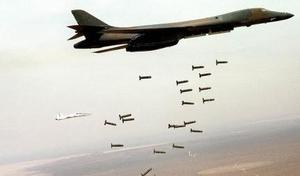Iran's bombA U.S. attack on about a half-dozen nuclear facilities would "defang" Iran
Iran has many potential nuclear weapons-related targets, but only about a half-dozen facilities are so critical that, if destroyed, would set back the program significantly; John Pike of Global Security.org: “Almost all [the high-value targets] are in isolated areas where civilian casualties would not be much of a problem. Most of them have co-located staff housing. Bomb the housing, kill the staff, set back the program by a generation”

An effective strike on a handful of targets stops Iran's nuclear program // Source: freedomsphoenix.com
A Pentagon strike against Iran would rely heavily on the B-2 bomber and cruise missiles to try to destroy the regime’s ability to make nuclear weapons, analysts say, after the top U.S. military officer said a war plan is in place.
The missiles, fired from surface ships, submarines, and B-52 bombers, would take out air defenses and nuclear-related facilities. The B-2s would drop tons of bombs, including ground penetrators, onto fortified and buried sites where Tehran is suspected of enriching uranium to fuel the weapons and working on warheads (on the shape of a likely Israeli attack on Iran’s nuclear weapons facilities, see “Report: Israel may attack Iran with missiles,” 18 March 2009 HSNW).
The Washington Times’s Rowan Scarborough quotes retired Air Force Lt. Gen. Thomas McInerney, a former fighter pilot, to say that “It will be primarily an air attack with covert work to start a ‘velvet’ revolution so [the] Iranian people can take back their country.”
Gen. McInerney said B-2s would fly over Iran while cruise missiles would be fired off shore. The operation would last several days, he said.
John Pike, a military analyst who runs Global Security.org, said that although Iran has many potential targets, only about a half-dozen facilities are so critical that, if destroyed, would set back the program significantly. “Almost all are in isolated areas where civilian casualties would not be much of a problem,” Mr. Pike said. “Most of them have co-located staff housing. Bomb the housing, kill the staff, set back the program by a generation.”
Pike’s Web site’s scenario (“A plan to Attack Iran Swiftly and from Above,” by Paul Korning) states: “American air strikes on Iran would vastly exceed the scope of the 1981 Israeli attack on the Osiraq nuclear center in Iraq, and would more resemble the opening days of the 2003 air campaign against Iraq. Using the full force of operational B-2 stealth bombers, staging from Diego Garcia or flying direct from the United States … two-dozen suspect nuclear sites would be targeted.”
Scarborough notes that the Obama administration this summer won the backing of the United Nations for another round of economic sanctions against Tehran, but there are doubts that limits on banking and trade would ever persuade the hard-line Islamic regime to give up plans to become a nuclear power.
Adm. Mike Mullen, chairman of the Joint Chiefs of Staff, drew public attention back to the military option on Sunday
